Copyright Cambridge University Press 2003. On-screen viewing permitted. Printing not permitted. http://www.cambridge.org/0521642981
You can buy this book for 30 pounds or $50. See http://www.inference.phy.cam.ac.uk/mackay/itila/ for links.
Information Theory, Inference, and Learning Algorithms
David J.C. MacKay
�
Copyright Cambridge University Press 2003. On-screen viewing permitted. Printing not permitted. http://www.cambridge.org/0521642981
You can buy this book for 30 pounds or $50. See http://www.inference.phy.cam.ac.uk/mackay/itila/ for links.
Information Theory,
Inference,
and Learning Algorithms
David J.C. MacKay
mackay@mrao.cam.ac.uk
c1995, 1996, 1997, 1998, 1999, 2000, 2001, 2002, 2003, 2004, 2005
cCambridge University Press 2003
Version 7.2 (fourth printing) March 28, 2005
Please send feedback on this book via
http://www.inference.phy.cam.ac.uk/mackay/itila/
Version 6.0 of this book was published by C.U.P. in September 2003. It will
remain viewable on-screen on the above website, in postscript, djvu, and pdf
formats.
In the second printing (version 6.6) minor typos were corrected, and the book
design was slightly altered to modify the placement of section numbers.
In the third printing (version 7.0) minor typos were corrected, and chapter 8
was renamed ‘Dependent random variables’ (instead of ‘Correlated’).
In the fourth printing (version 7.2) minor typos were corrected.
(C.U.P. replace this page with their own page ii.)
�
Copyright Cambridge University Press 2003. On-screen viewing permitted. Printing not permitted. http://www.cambridge.org/0521642981
You can buy this book for 30 pounds or $50. See http://www.inference.phy.cam.ac.uk/mackay/itila/ for links.
Contents
. . . . . . . . . . . . . . . . . . . . . . . . . . . . .
Preface
Introduction to Information Theory
. . . . . . . . . . . . .
Probability, Entropy, and Inference . . . . . . . . . . . . . .
. . . . . . . . . . . . . . . . . . . . .
1
2
3 More about Inference
I
Data Compression
. . . . . . . . . . . . . . . . . . . . . .
4
5
6
7
The Source Coding Theorem . . . . . . . . . . . . . . . . .
Symbol Codes
. . . . . . . . . . . . . . . . . . . . . . . . .
Stream Codes . . . . . . . . . . . . . . . . . . . . . . . . . .
Codes for Integers
. . . . . . . . . . . . . . . . . . . . . . .
v
3
22
48
65
67
91
110
132
II
Noisy-Channel Coding
. . . . . . . . . . . . . . . . . . . .
137
Dependent Random Variables . . . . . . . . . . . . . . . . .
8
Communication over a Noisy Channel
. . . . . . . . . . . .
9
10 The Noisy-Channel Coding Theorem . . . . . . . . . . . . .
11 Error-Correcting Codes and Real Channels
. . . . . . . . .
138
146
162
177
III
Further Topics in Information Theory . . . . . . . . . . . . .
191
12 Hash Codes: Codes for Ecient Information Retrieval
13 Binary Codes
14 Very Good Linear Codes Exist
15 Further Exercises on Information Theory
16 Message Passing
17 Communication over Constrained Noiseless Channels
18 Crosswords and Codebreaking
19 Why have Sex? Information Acquisition and Evolution
. .
. . . . . . . . . . . . . . . . . . . . . . . . .
. . . . . . . . . . . . . . . .
. . . . . . . . . .
. . . . . . . . . . . . . . . . . . . . . . . .
. . .
. . . . . . . . . . . . . . . .
. .
193
206
229
233
241
248
260
269
IV Probabilities and Inference . . . . . . . . . . . . . . . . . .
281
. . . . . . . . . . .
20 An Example Inference Task: Clustering
21 Exact Inference by Complete Enumeration
. . . . . . . . .
22 Maximum Likelihood and Clustering . . . . . . . . . . . . .
23 Useful Probability Distributions
. . . . . . . . . . . . . . .
24 Exact Marginalization . . . . . . . . . . . . . . . . . . . . .
25 Exact Marginalization in Trellises
. . . . . . . . . . . . . .
26 Exact Marginalization in Graphs
. . . . . . . . . . . . . . .
. . . . . . . . . . . . . . . . . . . . . . .
27 Laplace’s Method
284
293
300
311
319
324
334
341
�
Copyright Cambridge University Press 2003. On-screen viewing permitted. Printing not permitted. http://www.cambridge.org/0521642981
You can buy this book for 30 pounds or $50. See http://www.inference.phy.cam.ac.uk/mackay/itila/ for links.
Ising Models
. . . . . . . . . . .
28 Model Comparison and Occam’s Razor
. . . . . . . . . . . . . . . . . . . . .
29 Monte Carlo Methods
. . . . . . . . . . . . . . . .
30 Ecient Monte Carlo Methods
31
. . . . . . . . . . . . . . . . . . . . . . . . . .
32 Exact Monte Carlo Sampling . . . . . . . . . . . . . . . . .
33 Variational Methods
. . . . . . . . . . . . . . . . . . . . . .
34
Independent Component Analysis and Latent Variable Mod-
elling
343
357
387
400
413
422
437
445
451
457
35 Random Inference Topics
36 Decision Theory
37 Bayesian Inference and Sampling Theory
. . . . . . . . . . . . . . . . . . . . . . . . . . . . . .
. . . . . . . . . . . . . . . . . . .
. . . . . . . . . . . . . . . . . . . . . . . .
. . . . . . . . . .
V
Neural networks . . . . . . . . . . . . . . . . . . . . . . . .
467
Introduction to Neural Networks
38
. . . . . . . . . . . . . . .
39 The Single Neuron as a Classier . . . . . . . . . . . . . . .
40 Capacity of a Single Neuron . . . . . . . . . . . . . . . . . .
41 Learning as Inference
. . . . . . . . . . . . . . . . . . . . .
42 Hopeld Networks
. . . . . . . . . . . . . . . . . . . . . . .
43 Boltzmann Machines . . . . . . . . . . . . . . . . . . . . . .
44 Supervised Learning in Multilayer Networks . . . . . . . . .
45 Gaussian Processes
. . . . . . . . . . . . . . . . . . . . . .
. . . . . . . . . . . . . . . . . . . . . . . . .
46 Deconvolution
468
471
483
492
505
522
527
535
549
VI
Sparse Graph Codes
. . . . . . . . . . . . . . . . . . . . .
555
47 Low-Density Parity-Check Codes
. . . . . . . . . . . . . .
48 Convolutional Codes and Turbo Codes . . . . . . . . . . . .
. . . . . . . . . . . . . . . . . .
49 Repeat{Accumulate Codes
50 Digital Fountain Codes
. . . . . . . . . . . . . . . . . . . .
557
574
582
589
VII Appendices . . . . . . . . . . . . . . . . . . . . . . . . . .
597
. . . . . . . . . . . . . . . . . . . . . . . . . . . .
A Notation
. . . . . . . . . . . . . . . . . . . . . . . . . .
B Some Physics
C Some Mathematics
. . . . . . . . . . . . . . . . . . . . . . .
Bibliography . . . . . . . . . . . . . . . . . . . . . . . . . . . . .
Index . . . . . . . . . . . . . . . . . . . . . . . . . . . . . . . . .
598
601
605
613
620
�
Copyright Cambridge University Press 2003. On-screen viewing permitted. Printing not permitted. http://www.cambridge.org/0521642981
You can buy this book for 30 pounds or $50. See http://www.inference.phy.cam.ac.uk/mackay/itila/ for links.
Preface
This book is aimed at senior undergraduates and graduate students in Engi-
neering, Science, Mathematics, and Computing. It expects familiarity with
calculus, probability theory, and linear algebra as taught in a rst- or second-
year undergraduate course on mathematics for scientists and engineers.
Conventional courses on information theory cover not only the beauti-
ful theoretical
ideas of Shannon, but also practical solutions to communica-
tion problems. This book goes further, bringing in Bayesian data modelling,
Monte Carlo methods, variational methods, clustering algorithms, and neural
networks.
Why unify information theory and machine learning? Because they are
two sides of the same coin.
In the 1960s, a single eld, cybernetics, was
populated by information theorists, computer scientists, and neuroscientists,
all studying common problems. Information theory and machine learning still
belong together. Brains are the ultimate compression and communication
systems. And the state-of-the-art algorithms for both data compression and
error-correcting codes use the same tools as machine learning.
How to use this book
The essential dependencies between chapters are indicated in the gure on the
next page. An arrow from one chapter to another indicates that the second
chapter requires some of the rst.
Within Parts I, II, IV, and V of this book, chapters on advanced or optional
topics are towards the end. All chapters of Part III are optional on a rst
reading, except perhaps for Chapter 16 (Message Passing).
The same system sometimes applies within a chapter: the nal sections of-
ten deal with advanced topics that can be skipped on a rst reading. For exam-
ple in two key chapters { Chapter 4 (The Source Coding Theorem) and Chap-
ter 10 (The Noisy-Channel Coding Theorem) { the rst-time reader should
detour at section 4.5 and section 10.4 respectively.
Pages vii{x show a few ways to use this book. First, I give the roadmap for
a course that I teach in Cambridge: ‘Information theory, pattern recognition,
and neural networks’. The book is also intended as a textbook for traditional
courses in information theory. The second roadmap shows the chapters for an
introductory information theory course and the third for a course aimed at an
understanding of state-of-the-art error-correcting codes. The fourth roadmap
shows how to use the text in a conventional course on machine learning.
v
�
vi
1
2
3
Probability, Entropy, and Inference
More about Inference
I Data Compression
4
5
6
7
The Source Coding Theorem
Symbol Codes
Stream Codes
Codes for Integers
8
9
10
11
Dependent Random Variables
Communication over a Noisy Channel
The Noisy-Channel Coding Theorem
Error-Correcting Codes and Real Channels
III Further Topics in Information Theory
Hash Codes
Binary Codes
12
13
14
15
20
21
An Example Inference Task: Clustering
Exact Inference by Complete Enumeration
22 Maximum Likelihood and Clustering
23
24
25
26
27
Useful Probability Distributions
Exact Marginalization
Exact Marginalization in Trellises
Exact Marginalization in Graphs
Laplace’s Method
28 Model Comparison and Occam’s Razor
30
31
32
33
34
35
36
37
Ecient Monte Carlo Methods
Ising Models
Exact Monte Carlo Sampling
Variational Methods
Independent Component Analysis
Random Inference Topics
Decision Theory
Bayesian Inference and Sampling Theory
Copyright Cambridge University Press 2003. On-screen viewing permitted. Printing not permitted. http://www.cambridge.org/0521642981
You can buy this book for 30 pounds or $50. See http://www.inference.phy.cam.ac.uk/mackay/itila/ for links.
Introduction to Information Theory
IV Probabilities and Inference
Preface
II Noisy-Channel Coding
29 Monte Carlo Methods
Very Good Linear Codes Exist
Further Exercises on Information Theory
V Neural networks
16 Message Passing
17
18
Constrained Noiseless Channels
Crosswords and Codebreaking
19 Why have Sex?
Dependencies
38
39
40
41
42
43
44
45
46
Introduction to Neural Networks
The Single Neuron as a Classier
Capacity of a Single Neuron
Learning as Inference
Hopeld Networks
Boltzmann Machines
Supervised Learning in Multilayer Networks
Gaussian Processes
Deconvolution
VI Sparse Graph Codes
47
48
49
50
Low-Density Parity-Check Codes
Convolutional Codes and Turbo Codes
Repeat{Accumulate Codes
Digital Fountain Codes
�
Preface
1
1
2
2
3
3
Probability, Entropy, and Inference
Probability, Entropy, and Inference
More about Inference
More about Inference
I Data Compression
4
4
5
5
6
6
7
The Source Coding Theorem
The Source Coding Theorem
Symbol Codes
Symbol Codes
Stream Codes
Stream Codes
Codes for Integers
8
8
9
9
10
10
11
11
Dependent Random Variables
Dependent Random Variables
Communication over a Noisy Channel
Communication over a Noisy Channel
The Noisy-Channel Coding Theorem
The Noisy-Channel Coding Theorem
Error-Correcting Codes and Real Channels
Error-Correcting Codes and Real Channels
III Further Topics in Information Theory
Hash Codes
Binary Codes
12
13
14
15
20
20
21
21
An Example Inference Task: Clustering
An Example Inference Task: Clustering
Exact Inference by Complete Enumeration
Exact Inference by Complete Enumeration
22 Maximum Likelihood and Clustering
22 Maximum Likelihood and Clustering
23
24
24
25
26
27
27
Useful Probability Distributions
Exact Marginalization
Exact Marginalization
Exact Marginalization in Trellises
Exact Marginalization in Graphs
Laplace’s Method
Laplace’s Method
28 Model Comparison and Occam’s Razor
30
30
31
31
32
32
33
33
34
35
36
37
Ecient Monte Carlo Methods
Ecient Monte Carlo Methods
Ising Models
Ising Models
Exact Monte Carlo Sampling
Exact Monte Carlo Sampling
Variational Methods
Variational Methods
Independent Component Analysis
Random Inference Topics
Decision Theory
Bayesian Inference and Sampling Theory
Copyright Cambridge University Press 2003. On-screen viewing permitted. Printing not permitted. http://www.cambridge.org/0521642981
You can buy this book for 30 pounds or $50. See http://www.inference.phy.cam.ac.uk/mackay/itila/ for links.
Introduction to Information Theory
Introduction to Information Theory
IV Probabilities and Inference
vii
II Noisy-Channel Coding
29 Monte Carlo Methods
29 Monte Carlo Methods
Very Good Linear Codes Exist
Further Exercises on Information Theory
V Neural networks
16 Message Passing
17
18
Constrained Noiseless Channels
Crosswords and Codebreaking
19 Why have Sex?
My Cambridge Course on,
Information Theory,
Pattern Recognition,
and Neural Networks
38
38
39
39
40
40
41
41
42
42
43
44
45
46
Introduction to Neural Networks
Introduction to Neural Networks
The Single Neuron as a Classier
The Single Neuron as a Classier
Capacity of a Single Neuron
Capacity of a Single Neuron
Learning as Inference
Learning as Inference
Hopeld Networks
Hopeld Networks
Boltzmann Machines
Supervised Learning in Multilayer Networks
Gaussian Processes
Deconvolution
VI Sparse Graph Codes
47
47
48
49
50
Low-Density Parity-Check Codes
Low-Density Parity-Check Codes
Convolutional Codes and Turbo Codes
Repeat{Accumulate Codes
Digital Fountain Codes
�
viii
1
1
2
2
3
Probability, Entropy, and Inference
Probability, Entropy, and Inference
More about Inference
I Data Compression
4
4
5
5
6
6
7
The Source Coding Theorem
The Source Coding Theorem
Symbol Codes
Symbol Codes
Stream Codes
Stream Codes
Codes for Integers
8
8
9
9
10
10
11
Dependent Random Variables
Dependent Random Variables
Communication over a Noisy Channel
Communication over a Noisy Channel
The Noisy-Channel Coding Theorem
The Noisy-Channel Coding Theorem
Error-Correcting Codes and Real Channels
III Further Topics in Information Theory
Hash Codes
Binary Codes
12
13
14
15
20
21
An Example Inference Task: Clustering
Exact Inference by Complete Enumeration
22 Maximum Likelihood and Clustering
23
24
25
26
27
Useful Probability Distributions
Exact Marginalization
Exact Marginalization in Trellises
Exact Marginalization in Graphs
Laplace’s Method
28 Model Comparison and Occam’s Razor
30
31
32
33
34
35
36
37
Ecient Monte Carlo Methods
Ising Models
Exact Monte Carlo Sampling
Variational Methods
Independent Component Analysis
Random Inference Topics
Decision Theory
Bayesian Inference and Sampling Theory
Copyright Cambridge University Press 2003. On-screen viewing permitted. Printing not permitted. http://www.cambridge.org/0521642981
You can buy this book for 30 pounds or $50. See http://www.inference.phy.cam.ac.uk/mackay/itila/ for links.
Introduction to Information Theory
Introduction to Information Theory
IV Probabilities and Inference
Preface
II Noisy-Channel Coding
29 Monte Carlo Methods
Very Good Linear Codes Exist
Further Exercises on Information Theory
V Neural networks
16 Message Passing
17
18
Constrained Noiseless Channels
Crosswords and Codebreaking
19 Why have Sex?
Short Course on
Information Theory
38
39
40
41
42
43
44
45
46
Introduction to Neural Networks
The Single Neuron as a Classier
Capacity of a Single Neuron
Learning as Inference
Hopeld Networks
Boltzmann Machines
Supervised Learning in Multilayer Networks
Gaussian Processes
Deconvolution
VI Sparse Graph Codes
47
48
49
50
Low-Density Parity-Check Codes
Convolutional Codes and Turbo Codes
Repeat{Accumulate Codes
Digital Fountain Codes
�
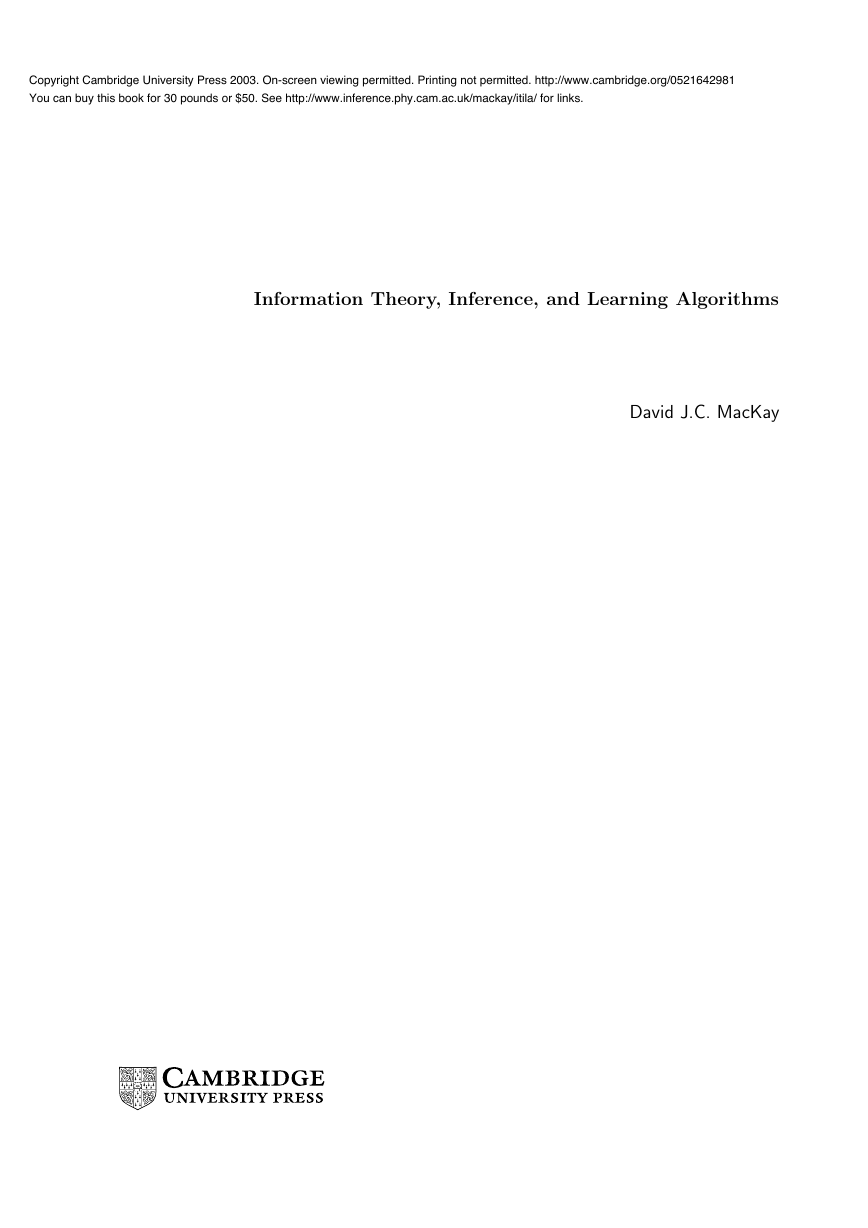
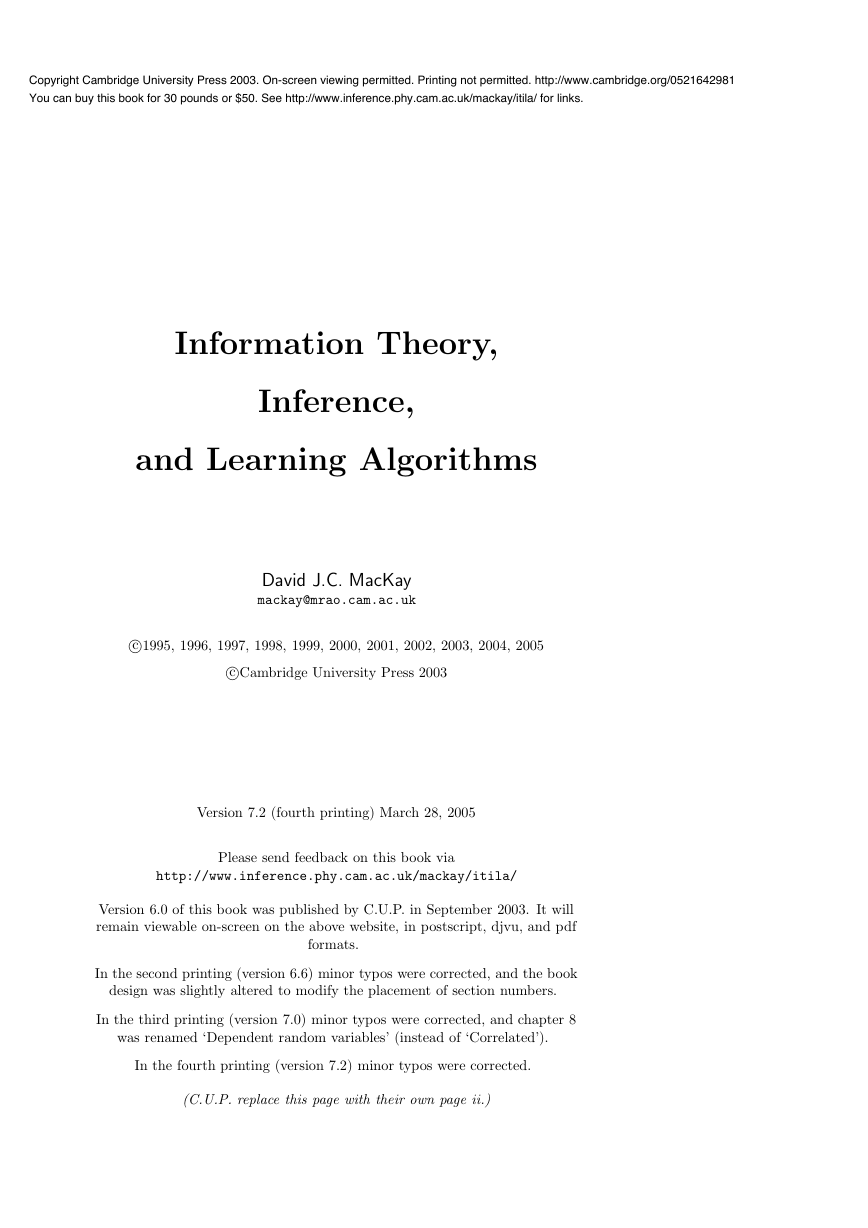
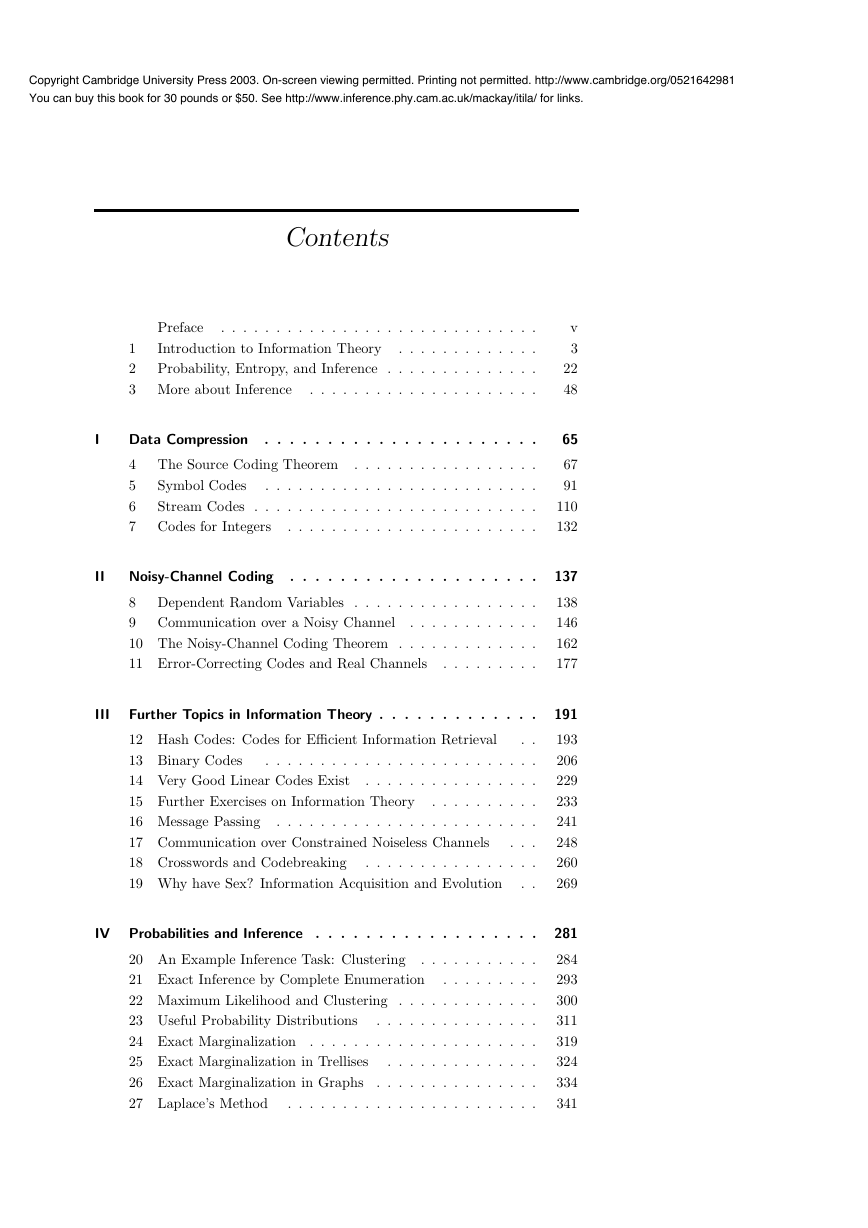

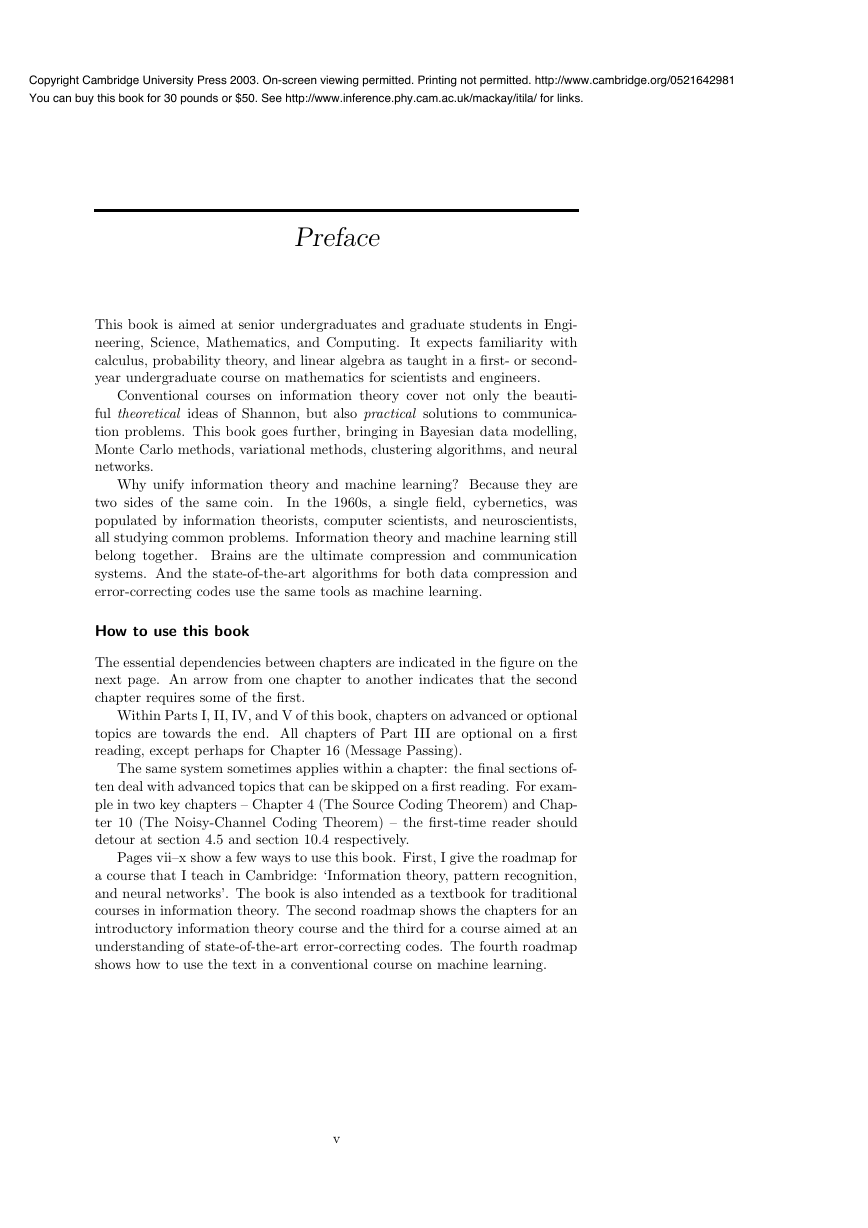
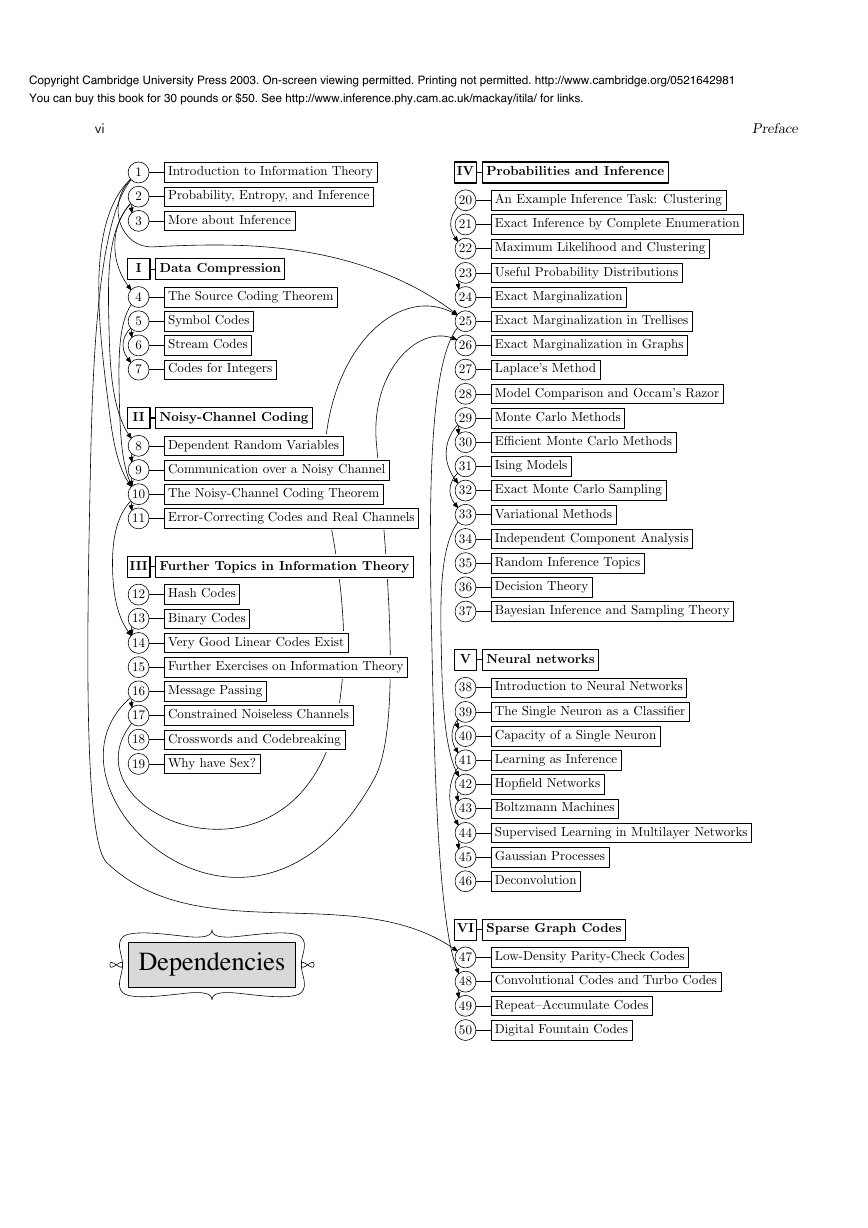
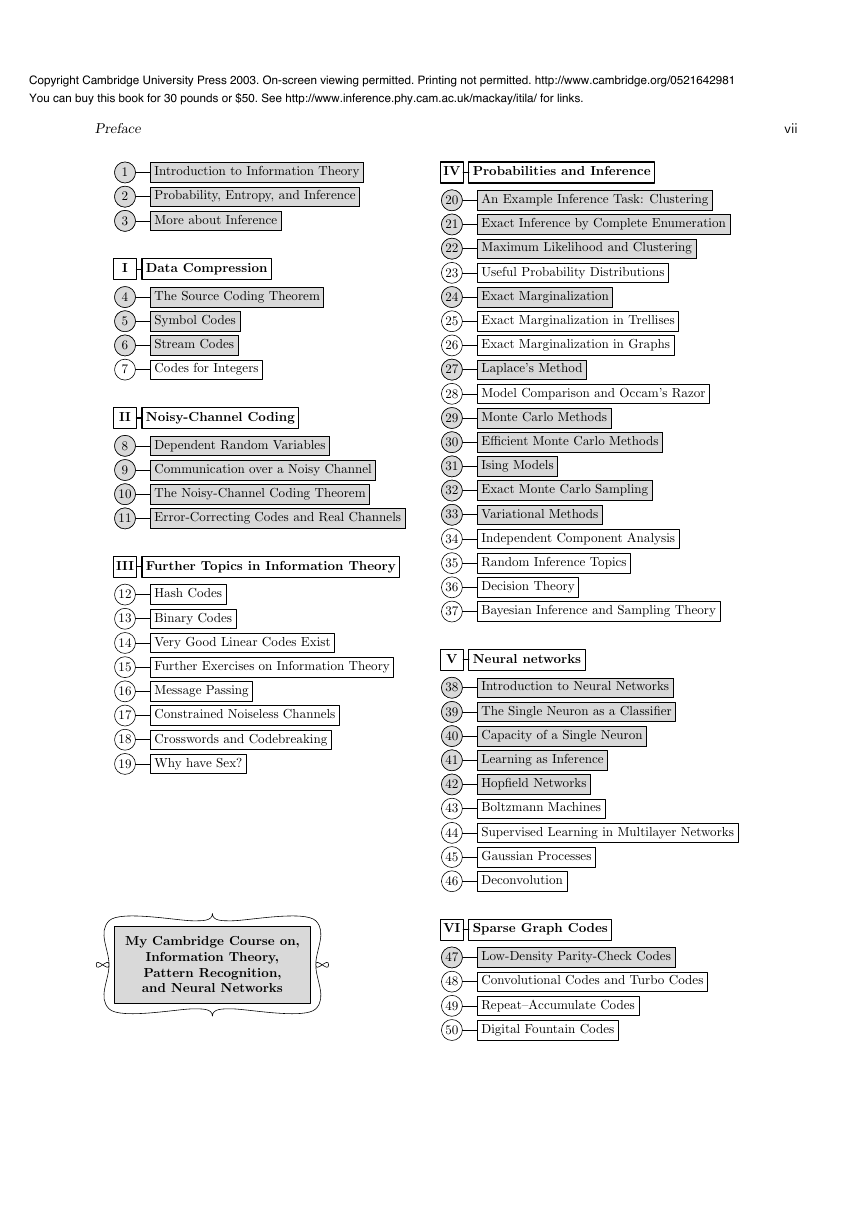
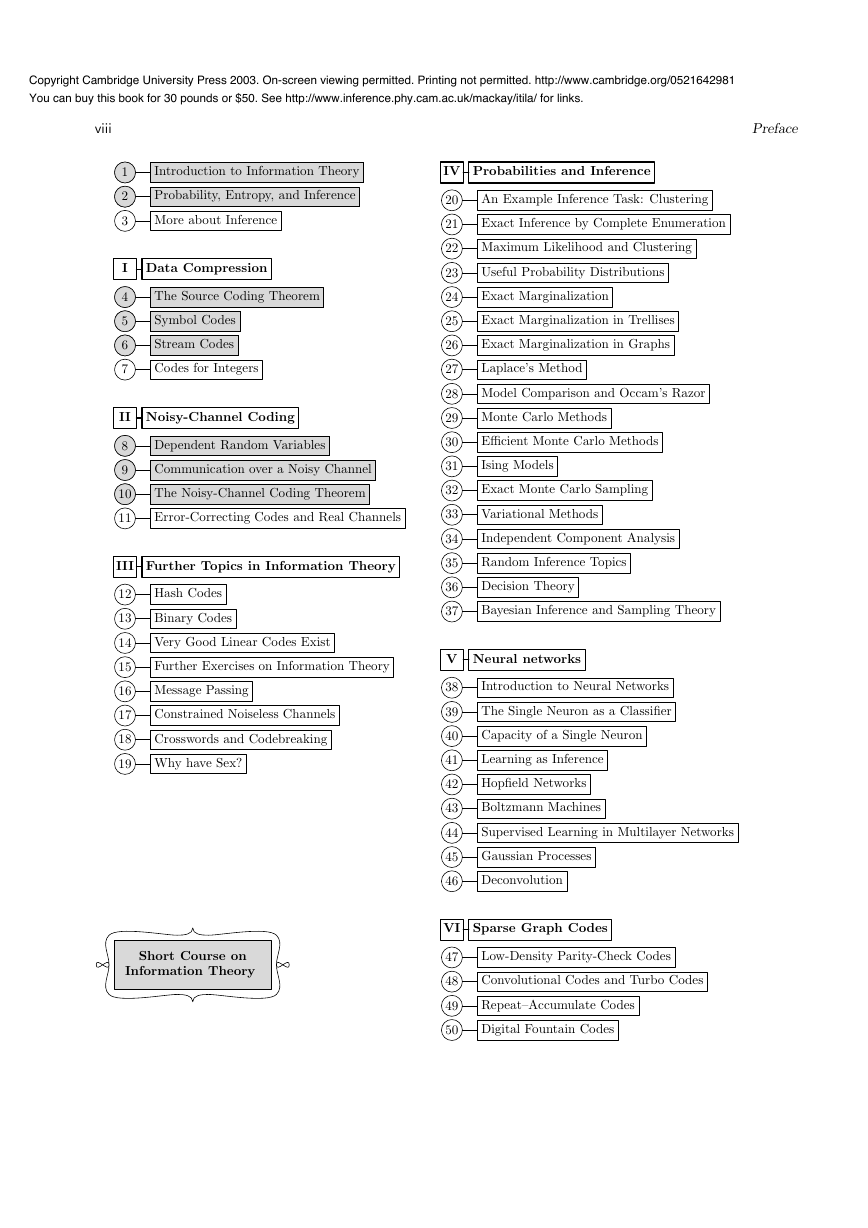








 2023年江西萍乡中考道德与法治真题及答案.doc
2023年江西萍乡中考道德与法治真题及答案.doc 2012年重庆南川中考生物真题及答案.doc
2012年重庆南川中考生物真题及答案.doc 2013年江西师范大学地理学综合及文艺理论基础考研真题.doc
2013年江西师范大学地理学综合及文艺理论基础考研真题.doc 2020年四川甘孜小升初语文真题及答案I卷.doc
2020年四川甘孜小升初语文真题及答案I卷.doc 2020年注册岩土工程师专业基础考试真题及答案.doc
2020年注册岩土工程师专业基础考试真题及答案.doc 2023-2024学年福建省厦门市九年级上学期数学月考试题及答案.doc
2023-2024学年福建省厦门市九年级上学期数学月考试题及答案.doc 2021-2022学年辽宁省沈阳市大东区九年级上学期语文期末试题及答案.doc
2021-2022学年辽宁省沈阳市大东区九年级上学期语文期末试题及答案.doc 2022-2023学年北京东城区初三第一学期物理期末试卷及答案.doc
2022-2023学年北京东城区初三第一学期物理期末试卷及答案.doc 2018上半年江西教师资格初中地理学科知识与教学能力真题及答案.doc
2018上半年江西教师资格初中地理学科知识与教学能力真题及答案.doc 2012年河北国家公务员申论考试真题及答案-省级.doc
2012年河北国家公务员申论考试真题及答案-省级.doc 2020-2021学年江苏省扬州市江都区邵樊片九年级上学期数学第一次质量检测试题及答案.doc
2020-2021学年江苏省扬州市江都区邵樊片九年级上学期数学第一次质量检测试题及答案.doc 2022下半年黑龙江教师资格证中学综合素质真题及答案.doc
2022下半年黑龙江教师资格证中学综合素质真题及答案.doc